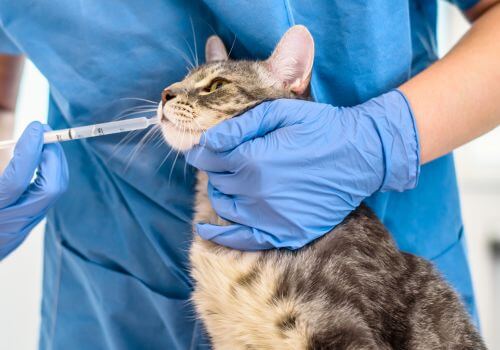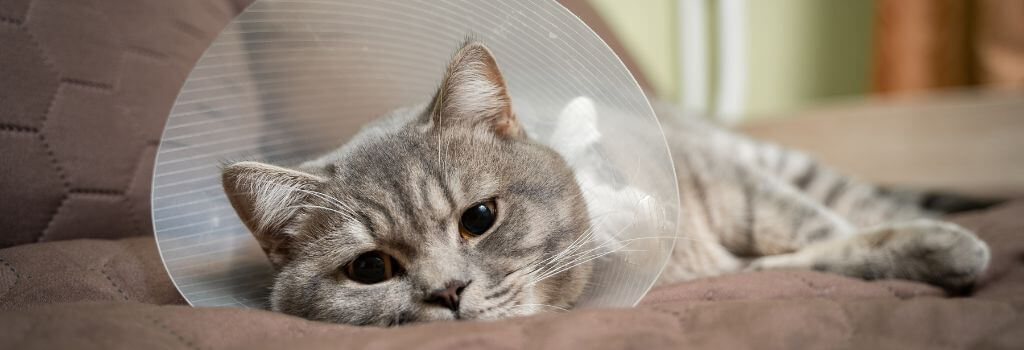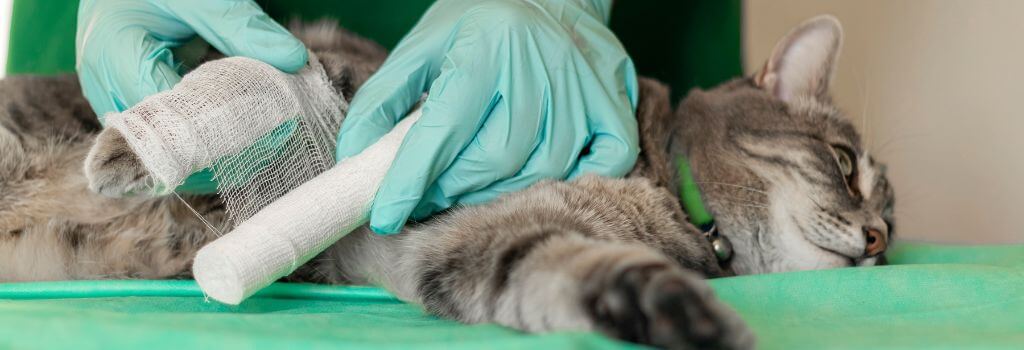Recognizing that your cat is in pain and needs help from a qualified veterinarian is crucial. However, because cats are the masters of masking pain symptoms, it is often difficult to tell when they are hurting. Many pet owners don’t know what to look for and often overlook subtle signs that something is wrong. At Peace of Mind Veterinary Care, we understand that you want to give your feline friend a healthy and comfortable life. That’s why we’re sharing some important information about the symptoms of pain in cats. We’ll also discuss potential treatment options. Read on to learn more.

How to Know if Your Cat is in Pain
Cats are notorious for hiding their discomfort, so it is important to pay attention to changes in your pet’s behavior, as they could indicate pain. Here are some signs and symptoms of pain in cats:
- Behavioral changes: Unusual aggression, hiding, increased irritability, withdrawal from social interactions, avoidance of being handled or touched.
- Grooming changes: Decreased grooming, grooming of only one area, or excessive grooming.
- Changes in activity level: Decreased activity, increased sleep, restlessness, or difficulty getting comfortable.
- Litter box changes: Eliminating outside of the litter box, changes in urine or fecal output (which could indicate painful health conditions)
- Decreased appetite: Loss of interest in eating or weight loss.
- Lethargy: Decreased interest in playing, social interaction, or exploring.
- Vocalization: Meowing more frequently than usual or with an urgent and unpleasant tone; groaning, hissing, growling.
- Changes in body language: Tension in their body, crouching, hunched posture, head lowering.
- Changes in daily routine: Avoiding activities that cause discomfort such as jumping onto raised surfaces or climbing stairs.
- Self-mutilation: Repetitively licking or biting at painful areas causing secondary trauma to the body.
If you suspect your cat is experiencing pain, contact your veterinarian as soon as possible for proper diagnosis and treatment. The faster you act, the sooner your feline friend will be back to feeling like themself again.
Why It’s Important to Avoid Self-Diagnosing Pain in Your Cat
The internet provides a wealth of information, and many pet owners may be tempted to use this information to self-diagnose their cats' pain. However, self-diagnosing can lead to a delay in obtaining proper veterinary care, providing incorrect treatment that could cause your cat to feel worse or worsen the problem, and potentially fatal consequences.
Be aware of subtle symptoms of pain, as your cat may not display outward signs unless the pain is acute or intense. If your cat displays any of the above signs or experiences a sudden change in habits and routines, contact your veterinarian right away. Attempting to self-diagnose your cat and delaying appropriate veterinary care could be fatal. Even in less severe cases, your cat’s discomfort will likely continue to worsen if you don’t seek help from a vet.

How a Veterinarian Will Know if Your Cat is in Pain
Veterinarians rely on careful observation of a cat's behavior, posture, facial expressions, and interactions with humans to assess pain levels. They also use pain scoring scales and pain management guidelines to evaluate the degree of a cat's discomfort and promote a standard of care for patients. Objective measures of pain, such as changes in heart rate, blood pressure, and plasma cortisol levels, can also be used but may be influenced by other factors like fear, stress, anesthesia, or pharmacologic interventions.
In addition to assessing the degree of pain your cat is feeling based on behavioral signs and objective measurements, your veterinarian will perform a physical examination to determine the cause of a cat's discomfort. This includes examining the area where the cat is exhibiting signs of pain as well as checking other areas for abnormalities that could indicate potential causes of pain, such as infections or inflammation. Depending on the veterinarian’s findings during the exam, additional testing may be necessary for diagnosis (e.g., radiographs or laboratory tests).
Possible Conditions That Cause Cat Pain and Treatment Options
There are several conditions that can cause pain in cats. Here is a list of some common conditions and their potential treatments:
- Arthritis: Non-steroidal anti-inflammatory drugs (NSAIDs) such as meloxicam (Metacam or Loxicom) and robenacoxib (Onsior), frunevetmab (Solensia), gabapentin, opioids, acupuncture, and weight management/exercise.
- Trauma or injury: Depending on the severity of the injury, treatment may include pain medications, physical therapy, rest, or surgery.
- Infections: Antibiotics and/or anti-fungal medications, corticosteroids to reduce inflammation, topical treatments, fluid therapy, nutritional support, nursing care.
- Cancer: Surgery to remove tumors or affected tissue, chemotherapy, radiation therapy, immunotherapy, pain medications.
- Urinary tract blockage or stones: Surgery to remove the obstruction, dietary changes to help prevent further episodes of obstruction, antibiotics if an infection is present, increased water intake with fluids such as canned food or broths for cats with decreased appetite due to illness/pain, urinary acidifiers if struvite crystals are present in the urine.
- Digestive problems: Diet changes such as high fiber foods or hydration through subcutaneous fluids if dehydration is an issue, probiotics for digestive upset, anti-nausea medications for vomiting cats, antibiotics if an infection is present, tube feeding if there is poor appetite due to illness/pain.
- Exposure to extreme temperatures: Keeping cats indoors when temperatures drop below freezing and providing them with warm bedding in a draft-free area during cold weather months can help keep them comfortable and safe from cold exposure related pain. Additionally, providing access to shade and cool water during hot weather months can help reduce discomfort associated with heat exposure related pain.
- Dental conditions: Cleaning teeth with special dental tools under general anesthesia in order to remove tartar and plaque buildup, addressing other dental issues requiring attention such as cavities or abscesses that could be causing pain in cats’ mouths, pain medications.
Types of Pain Medications Your Veterinarian Might Prescribe
Non-steroidal anti-inflammatory drugs (NSAIDs) are the most commonly used and effective type of pain medication for cats. NSAIDs work by inhibiting inflammatory substances called prostaglandins, which cause pain, inflammation, and fever. Potential side effects include gastrointestinal disturbance (vomiting, diarrhea, bloody or dark-colored feces), liver/kidney failure. Never give your cat over-the-counter pain medication unless directed to do so by your veterinarian.
Opioids work by blocking a cat's ability to recognize pain and are prescribed in rare cases. Examples include Buprenorphine, Morphine, and Codeine. They are generally used only in severe cases on a short-term basis due to DEA regulations and the development of tolerance in pets.
Steroids can be used to control inflammation that can cause severe pain, but they are often avoided, as they can have serious side effects like increased thirst/appetite/urination, weight gain, increased risk of infection, delayed wound healing, behavioral changes, and more.
In addition to NSAIDs, opioids, and steroids, other medications may also be prescribed depending on what’s causing your cat’s pain. For example, Gabapentin treats pain from damaged nerves in both humans and pets, while tramadol is a mild opioid medication used for aging pets with chronic discomfort.

The Most Important Consideration When it Comes to Cat Pain Management
The most important consideration when it comes to cat pain management is recognizing the unique ways cats express pain while considering the human-cat bond and minimizing stress. Utilizing a multimodal approach, including appropriate medications and environmental modifications, can help your feline friend live a comfortable and pain-free life.
We understand how painful conditions can affect our feline companions, which is why we strive to deliver the highest quality of care in a compassionate manner. Our team of experienced veterinarians will work with you to develop an individualized plan that addresses your cat’s specific needs to restore their comfort and improve their quality-of-life.
Conclusion
Identifying signs of pain in cats and seeking help from your veterinarian is essential in ensuring your cat receives the best care possible. Watch for behavioral changes, and seek prompt veterinary care if you think something is wrong. Avoid self-diagnosing, as it can lead to incorrect treatment and potentially serious consequences.
If you are located in or near Burnsville, MN and think your feline friend might benefit from pain management, please schedule an appointment with us today by calling (952) 435-7194. We’re also here to help if you have any questions or concerns about your cat’s health.
